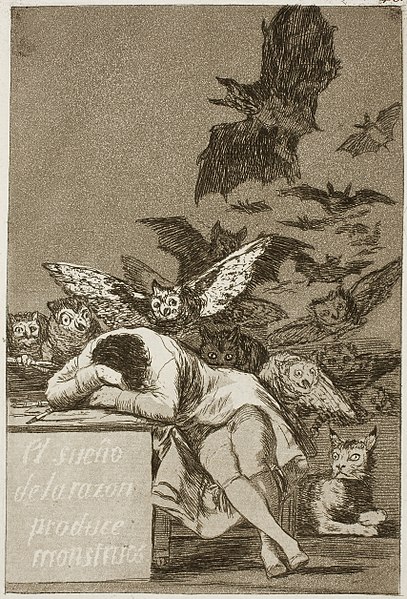Los caprichos is a set of 80 prints in aquatint and etching created by the Spanish artist Francisco Goya in 1797–1798, and published as an album in 1799. The prints were an artistic experiment: a medium for Goya's condemnation of the universal follies and foolishness in the Spanish society in which he lived. The criticisms are far-ranging and acidic; the images expose the predominance of superstition, the ignorance and inabilities of the various members of the ruling class, pedagogical short-comings, marital mistakes and the decline of rationality. Some of the prints have anticlerical themes. Goya described the series as depicting "the innumerable foibles and follies to be found in any civilized society, and from the common prejudices and deceitful practices which custom, ignorance or self-interest have made usual".

No. 43, The Sleep of Reason Produces Monsters, a print from the first edition which is held at the Prado Museum. The work is an etching with aquatint and other intaglio media on laid paper.
Drawing from "Álbum A": Woman (possibly the Duchess of Alba) arranging her hair.
Drawing from "Álbum A": a sketch for the capricho Bien tirada está (It is nicely stretched).
Capricho No. 1: Francisco Goya y Lucientes, pintor (Francisco Goya y Lucientes, painter)
Aquatint is an intaglio printmaking technique, a variant of etching that produces areas of tone rather than lines. For this reason it has mostly been used in conjunction with etching, to give both lines and shaded tone. It has also been used historically to print in colour, both by printing with multiple plates in different colours, and by making monochrome prints that were then hand-coloured with watercolour.
1835 aquatint showing the first production of I puritani. Note range of tones.
Demonstration sections of printed aquatint, magnified.
Goya, No. 32 of Los Caprichos (1799, Por que fue sensible). This is a fairly rare example of a print entirely in aquatint.
Philibert-Louis Debucourt, The Public Promenade, 1792. Printed in colour from various plates, using etching, engraving, and aquatint. One of the leading achievements of the French 18th-century colour-print.








